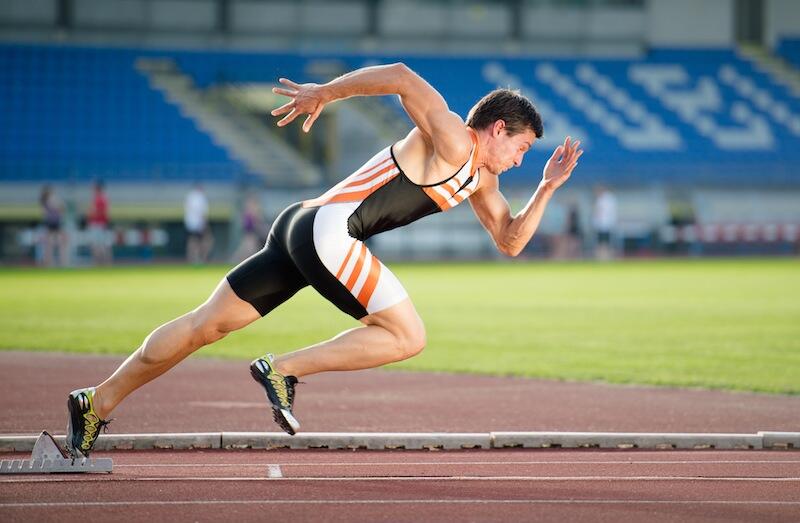
Aug. 22, 2016
Olympic injuries are common injuries
Share this story
Haitian runner Jeffrey Julmis plunged knees first into the first hurdle during the men's 110-meter hurdles semifinals, but was uninjured. Other athletes who were part of the 2016 Olympic Games in Rio de Janeiro weren’t so lucky.
Samir Ait, a French gymnast, suffered a broken leg during a vault exercise, and at least two bicyclists suffered collarbone and other serious injuries during cycling competitions. Athletic injuries are common for Olympians who train and perform rigorously during the grueling, 16-day tournament that features contests ranging from table tennis to basketball. And, their injuries occur despite presumably top-notch training and physical therapy resources.
To that end, athletes of every caliber and skill level should take the necessary precautions to avoid injury, said Katherine Dec, M.D., a professor in the Virginia Commonwealth University Department of Physical Medicine and Rehabilitation and the Department of Orthopaedic Surgery.

With the games now over, and fall sports practices beginning for high school and college students, the athletic ardor of the Olympics should be a lesson to all athletes, Dec said, because any athlete is susceptible to injury. Dec, who served as a physician during the 2008 Paralympics in Beijing, spoke to VCU News about the prevalence of injuries during the Olympics, what athletes can do to stay healthy and offered insight into cupping and other therapies used by elite athletes.
Are injuries inevitable during a time as competitive, rigorous and important as the Olympics?
I would not say they are inevitable, but injuries can occur in competition or practice during competitive events such as the Olympics. These competitions involve many months to years of high-level training for athletes, and the athletes are supported throughout their preparation and competition by outstanding medical staff and coaching. But, that does not exclude them from ever becoming injured.
What are some sports and the associated injuries that are common, not just for Olympians but for any athlete?
Overuse injuries can be associated with all sports, all athletes, at any age or level of competition. As the medical director for the Richmond Marathon, I tend to see more lower extremity-related issues at this time of year in our runners. These can include muscle strains, such as the calf (gastrocnemius or soleus), thigh (hamstring muscle group), or ligament sprains such as the ankle or knee joints, and foot-specific injuries such as plantar fasciitis, or stress injuries to the bones of the foot. [Athletes competing in] sports such as volleyball and basketball can experience shoulder injuries due to overuse, such as tendinitis and rotator cuff injuries, in addition to hand and thumb injuries. Think of the sport, pinpoint the skills of the sport, and the repetitive or impact areas for those skill-specific movements will be commonly associated injury sites.
Is cupping therapy a new treatment?
No, we have been using cupping as part of our manual therapy for several years. All athletes can and do use cupping as a treatment therapy. There are different types of cupping and it has been used in traditional Chinese medicine treatments for many decades. The cupping therapy as we utilize it is for addressing musculoskeletal components of pain and restriction. Large muscle groups and back muscles are often addressed. There is not extensive research addressing objective benefits. Our athletes often find it works quickly for recalcitrant myofascial restrictions and less muscle pain and tightness after treatment.
What type of training and preventative care do Olympic athletes have access to that everyday athletes may not?
During the Olympic Games the athletes have an outstanding staff of medical physicians, certified athletic trainers and physical therapists that can provide care for overuse or more traumatic injuries around-the- clock. This is different than the typical athlete competing at a tournament or a weekly club game. Depending on the athlete and sport, some Olympic athletes have additional training and performance assessment opportunities that the everyday athlete may not have. Leading up to the weeks before the games, further concentration of effort and attention is directed toward Olympic athletes than would happen for an everyday athlete preparing for state championships, for example.
At VCU, what athletic training and rehabilitative services do we offer to student-athletes?
We have certified athletic trainers that work with patients in our clinics and youth and college athletes on the field or courtside. We have physicians, athletic trainers and physical therapists that can provide rehabilitative and interventional treatments, in addition to surgical treatment as needed. We have the ability to assist all athletes through assessment, diagnosis, and rehabilitation of injuries. We have expertise in clinical assessment and diagnosis, imaging, compartment testing, 3-D gait analysis, acupuncture, and additional specialty areas such as computerized testing for sports concussions, counseling, and nutritional components with our professional team. At our new Neuroscience, Orthopedics and Wellness location we have multidisciplinary treatment across medical specialties in one location.
What are the fundamentals of avoiding injury for any athlete?
Since most injuries are non-surgical and overuse in nature, preparing for practice and competition with strength and aerobic training is important. Proper form and skill acquisition is also important. When we discuss training and preparation, this involves flexibility, full-body movements and engaging core movement. It involves hydrating and fueling nutritionally to maximize the body’s ability to compete. It also involves proper sleep, and work/rest intervals in training. All of these efforts will help minimize injury risk.
Subscribe to VCU News
Subscribe to VCU News at newsletter.vcu.edu and receive a selection of stories, videos, photos, news clips and event listings in your inbox.










